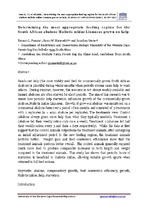| dc.contributor.author | Francis, Tamson | |
| dc.contributor.author | Maneveldt, Gavin | |
| dc.contributor.author | Venter, Jonathan | |
| dc.date.accessioned | 2013-06-12T14:24:05Z | |
| dc.date.available | 2013-06-12T14:24:05Z | |
| dc.date.issued | 2008 | |
| dc.identifier.citation | Francis, T., et al. (2008). Determining the most appropriate feeding regime for the South African abalone Haliotis midae Linnaeus grown on kelp. Journal of Applied Phycology, 20: 597‐602 | en_US |
| dc.identifier.issn | 0921-8971 | |
| dc.identifier.uri | http://hdl.handle.net/10566/634 | |
| dc.description.abstract | Beach-cast kelp (the most widely used feed for commercially grown South African
abalone) is plentiful during winter months when periodic storms cause kelp to wash
ashore. During summer, however, this resource is not always readily available and
farmed abalone are often starved for short periods. The aim of this research was to
assess how periodic kelp starvation influences growth of the commercially grown
abalone, Haliotis midae Linnaeus. Growth of grow-out abalone was monitored on a
commercial abalone farm over a period of six months and consisted of 3 treatments
with 2 replicates (n = ±250 abalone per replicate). The treatments were: Control
(abalone always given more kelp than what they typically needed); Treatment 1
(abalone fed their weekly ration only once a week); Treatment 2 (abalone fed half
their weekly ration every 3 and then 4 days respectively). While the data at first
suggest that the control animals outperform the treatment animals, after undergoing
an initial adjustment period to the new feeding regime, the treatment animals
perform better. Weight gain and feed conversion efficiencies show that the
treatment animals perform better overall. The control animals generally required
much more feed to produce comparable increases in both length and weight
compared to the treatment animals. This study has shown that periodic bouts of
starvation is beneficial to Haliotis midae, allowing variable growth spurts when
returned to full feed rations. | en_US |
| dc.language.iso | en | en_US |
| dc.publisher | Springer Verlag | en_US |
| dc.rights | This is the author's final draft following peer review. It may be displayed and circulated, subject to full acknowledgement of author and source. The published item is copyright Springer Verlag. | |
| dc.source.uri | http://dx.doi.org/10.1007/978-1-4020-9619-8_19 | |
| dc.subject | Abalone | en_US |
| dc.subject | Compensatory growth | en_US |
| dc.subject | Feed conversion efficiency | en_US |
| dc.subject | Growth | en_US |
| dc.subject | Haliotis midae | en_US |
| dc.subject | Kelp | en_US |
| dc.subject | Starvation | en_US |
| dc.title | Determining the most appropriate feeding regime for the South African abalone Haliotis midae Linnaeus grown on kelp | en_US |
| dc.type | Article | en_US |
| dc.privacy.showsubmitter | false | |
| dc.status.ispeerreviewed | true | |
| dc.description.accreditation | Web of Science | en_US |

